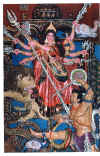| the-south-asian.com DECEMBER 2001 | ||
| about us contact us data bank past issues the craft shop the print gallery | ||
|
DECEMBER 2001 Contents Architecture Joseph
Allen Stein
Prem
Joshua Maharaja
Telecoms
& Software Value/Wealth Creators
Literature/Books 'It
was five past midnight Simplifying
Ramayana
Wharton
India Economic
Books
|
Page 1 of 2
Sakti - the Mother Goddess by Dr. Manoshi Bhattacharya
Tracing
the evolution of Sakti
(the all-powerful Female Goddess) ,
in India, from the ancient texts The mother Goddess
in India is seen as one with many forms combining both the fertility and
nurturing image as well as a dynamic virgin warrior representing the
‘Sakti’ or the combined strength
of the entire pantheon. Some
scholars have traced the origin of the mother Goddess to Prevedic times.
J. Marshall who excavated the Indus Valley felt that the Sakti cult
evolved from the Mother goddess cult associated with the proto Siva cult
(2600 BC –2000 BC) Vedic
Texts In
the Rig Veda (the earliest known text- the first
book of Knowledge) and the Samahitas there is no mention of Sri or
Laxmi. The Rig Veda represents
the time of the Aryan movement into India. The ten chapters describe the
lands they occupied in a sequence from Sind, Kashmir, the areas near the
rivers Beas and Sutlej, Baluchistan the Swat valley etc.
The tenth chapter, which includes the Sri sukta describing her glory, appears to be a late supplement to
the Rig Veda differing both in language and in subject. Khilaratri sukta – mentions the Goddesses Mahalaxmi ,Mahasaraswati
and Mahakali . – In Mahabharata, archeologicaly thought to be older than
the Ramayana, - Durga is mentioned in Arjun’s Hymn. Yudishtra invokes
her as the Mahisasura Mardini with 4 arms & 4 faces holding a noose,
bow and arrow and a disc.
-Ramayan - Before starting for his battle with Ravana, Rama wanted
the blessings of Devi Durga . He came to know that the Goddess would be
pleased only if she is worshipped with one hundred 'NeelKamal' or blue
lotuses. Rama, after travelling the whole world, could gather only ninety
nine of them. He finally decided to offer one of his eyes, which resembled
blue lotuses. Durga, being pleased with the devotion of Rama, appeared
before him and blessed him. Puranas Puranas
were written during the Gupta Period beginning 320 AD. Before the
Guptas, India was under predominantly Buddhist/ Jain influence. The Guptas
were the first strong Hindu rulers and they ordered their scholars to
commit to writing the ancient Hindu teachings and epics. The Puranas were
a product of these times and they elevated Durga to the highest position,
abandoning with enthusiasm the entire male pantheon. The
Mother who was denied by the Patriarchal Aryans was now firmly back on her
throne. She now evolved into two forms 1.
Mahisasura
Mardini – the virgin warrior. 2.
Uma/ Sati/ Parvati/ Himavati – the fertile nurturing form of the goddess
- the devoted wife of Siva -
Markandya
Puran – she first appears while Vishnu is asleep and she kills the
demons or the Asuras, Madhu and Kaiatabha. Devi Mahatmya section describes
Mahisasura Mardini as we know today. She is called Sivaduti , as Siva was
her messenger -
Vamana
Puran – Pulatsya tells Narad of the origin of Mahisasura Mardini here
called Katayani .As Kaushiki she slays Sumbha and Nishumbha. -
Devi
Bhagwat Puran - origin of Mahisasura Mardini -
Siva
puran - origin of Mahisasura Mardini -
Skanda
Puran – Kartik explains to Agastya as to why his mother is named Durga.
The demon Durg misusing a boon granted by Brahma conquered the 3 worlds,
banned all vedic practices and forced the earth to bear fruit out of
season. Parvati, unable to defeat him in her form as Kalratri, assumed her
1000 armed form and defeated him. Skanda also goes on to say that
Mahisasura sent a proposal of marriage to Gauri who was performing a
tapasya for a brave husband. In having to prove his valour Mahisasura was
forced into combat with Gauri. -
Chandi
Mahatyama – celebrates the victories of the goddess under the following
names – Durga, Dasabhuja, Mahisasura Mardini, Simhavahini, Jagadhatri,
Kali, Muktakesi, Tara, Chinnamosta, Jagad gauri. Varaha Puran – Siva (Pinaki) created Kumari, with dark skin
and curly black hair, to kill Andhaka. The individual mothers are identified by their weapons,
ornaments and mounts. This cult disappears by the 11th century AD absorbed by the growing worship
of Sakti in the combined form
Copyright © 2000 - 2001 [the-south-asian.com]. Intellectual Property. All rights reserved. |
|
